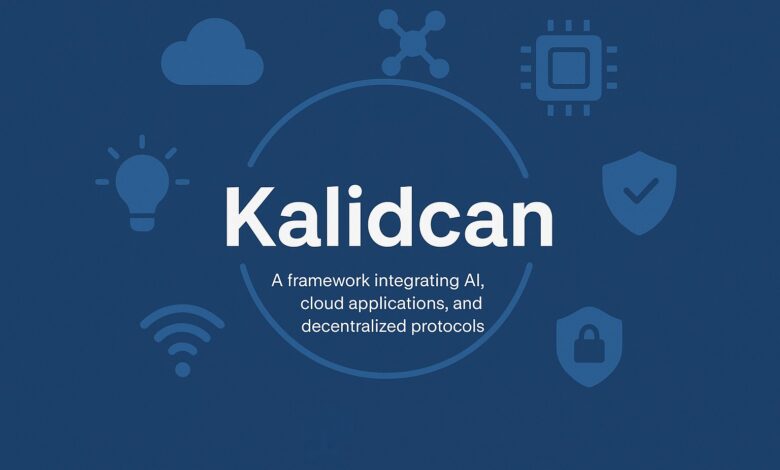Kalidcan: A Revolutionary Framework for Digital Transformation and Smart Systems
Kalidcan: Revolutionizing Digital Transformation with AI, Cloud Applications, and Decentralized Protocols

Introduction: The Future of Digital Systems
In today’s fast-paced, technology-driven world, digital transformation is no longer a luxury but a necessity for businesses and industries aiming to stay competitive. One of the most promising frameworks emerging in the realm of digital transformation is Kalidcan. Kalidcan is a cutting-edge digital framework designed to integrate advanced technologies like AI, edge computing, cloud infrastructure, and IoT into cohesive, secure, and scalable solutions.
This article explores Kalidcan’s features, its core applications, and how it leverages digital transformation, AI-driven systems, and decentralized protocols to create smarter and more efficient systems across various sectors.
What Is Kalidcan?
Kalidcan’s Foundation
Kalidcan is a digital framework that brings together cloud-native architecture, edge computing, and AI integration to create highly scalable, real-time, and secure digital systems. It is designed to handle the complexities of modern technology infrastructures, offering a unified approach to smart systems and digital ecosystems.
Core Features of Kalidcan
1. Smart Connectivity and Real-Time Data Processing
At its core, Kalidcan is built to support real-time data processing and smart connectivity across devices and systems. This enables quick, data-driven decision-making and facilitates the integration of IoT devices in real-time applications. The ability to process and analyze large volumes of data quickly and efficiently is a key feature that makes Kalidcan stand out as a digital transformation tool.
2. Cloud-Native and Hybrid Cloud Solutions
Kalidcan utilizes cloud-native architecture, meaning it is optimized to run seamlessly in cloud environments. It is designed to scale easily as businesses grow, with hybrid cloud solutions that provide the flexibility of using both private and public cloud services. This makes it an ideal choice for businesses that need to balance security with scalability.
3. Edge Computing Integration
Kalidcan incorporates edge computing, allowing data to be processed closer to the source. This reduces latency and ensures faster processing times, which is crucial for applications that require immediate decision-making, such as in autonomous systems and smart cities.
Key Applications of Kalidcan
1. Smart Cities and Infrastructure
Kalidcan is revolutionizing the way cities function by enabling smart infrastructure and digital ecosystems. By integrating IoT sensors and AI-driven systems, Kalidcan allows cities to manage resources efficiently, improve public services, and enhance community engagement.
For instance, Kalidcan can help manage energy consumption, traffic flow, and waste disposal through real-time data analysis. This leads to more sustainable development and smart city technologies that create a better quality of life for urban residents.
2. Healthcare Industry Transformation
In the healthcare sector, Kalidcan’s ability to process real-time data and integrate IoT devices opens the door for more efficient patient care. Medical devices can be connected to the system, providing continuous monitoring and real-time updates for medical professionals. Kalidcan’s edge computing capabilities further reduce the time it takes to process patient data, enabling quick responses and improved health outcomes.
3. Manufacturing and Industry 4.0
Kalidcan’s integration of IoT platforms and AI algorithms allows for intelligent automation in manufacturing. By leveraging predictive analytics and data-driven decision-making, businesses can optimize supply chains, monitor production lines, and minimize downtime. This results in higher efficiency, cost savings, and faster production cycles.
Decentralization and Blockchain Integration
1. Blockchain Technology
Kalidcan also incorporates blockchain technology to enhance security and ensure data integrity in distributed networks. By using decentralized protocols, Kalidcan makes it possible to process transactions and share data without relying on a central authority. This is especially beneficial for industries that require transparency, such as finance and healthcare.
2. Smart Contracts and Tokenization
Kalidcan utilizes smart contracts and tokenization to create decentralized applications (dApps) that automate business processes. Smart contracts are self-executing contracts with the terms of the agreement directly written into code. This reduces the need for intermediaries and ensures faster, secure transactions.
Security and Privacy Features
1. Cybersecurity Frameworks
Kalidcan places a strong emphasis on cybersecurity by integrating robust security protocols into its architecture. With features such as data encryption, multi-factor authentication (MFA), and identity and access management (IAM), Kalidcan ensures that data is secure both in transit and at rest.
2. Privacy-Enhancing Technologies
Kalidcan also prioritizes privacy through the use of privacy-enhancing technologies, such as data anonymization and compliance with privacy regulations like GDPR. This makes Kalidcan a valuable tool for businesses that handle sensitive data and must adhere to stringent data privacy laws.
Kalidcan’s Impact on Business Strategy and Innovation
1. Digital Business Models
Kalidcan is helping businesses transform their operations by enabling them to implement digital business models. By offering cloud scalability, AI-driven solutions, and automation frameworks, Kalidcan helps companies become more agile and competitive. This allows businesses to better meet customer needs and adapt to market changes.
2. Innovation Ecosystems
By fostering innovation ecosystems, Kalidcan encourages the development of new products and services. Businesses can leverage AI integration, IoT platforms, and decentralized protocols to create innovative solutions that disrupt traditional industries.
3. Agile Methodologies and Lean Principles
Kalidcan supports agile methodologies and lean startup principles, making it easier for businesses to innovate and iterate on new ideas. This enables organizations to quickly adapt to customer feedback and market demands, accelerating time-to-market for new products.
FAQ About Kalidcan
What is Kalidcan?
Kalidcan is a digital framework that integrates AI, edge computing, cloud infrastructure, and IoT technologies to create scalable, secure, and efficient digital systems for businesses and industries.
How does Kalidcan support digital transformation?
Kalidcan supports digital transformation by enabling businesses to create smarter, more connected systems that leverage real-time data processing, cloud-native architecture, and AI-driven decision-making.
What industries can benefit from Kalidcan?
Kalidcan can benefit industries like smart cities, healthcare, manufacturing, and finance, where real-time data processing, security, and scalability are crucial.
How does Kalidcan ensure security?
Kalidcan integrates robust cybersecurity frameworks, data encryption, multi-factor authentication (MFA), and blockchain technology to ensure that data remains secure in all transactions and processes.
What are the benefits of using Kalidcan?
The benefits of using Kalidcan include improved efficiency, real-time decision-making, enhanced security, scalability, and the ability to create intelligent, connected systems across various sectors.
Conclusion
Kalidcan is a game-changing framework for digital transformation that integrates the latest technologies like AI, IoT, edge computing, and blockchain into one cohesive solution. By leveraging these technologies, Kalidcan is helping businesses and industries achieve greater scalability, efficiency, and security. Whether in smart cities, healthcare, or manufacturing, Kalidcan is poised to revolutionize the way digital systems are built, managed, and utilized.
As businesses continue to embrace digital ecosystems, Kalidcan stands out as a powerful tool that not only supports but accelerates the shift towards more connected, intelligent, and secure digital infrastructures.



